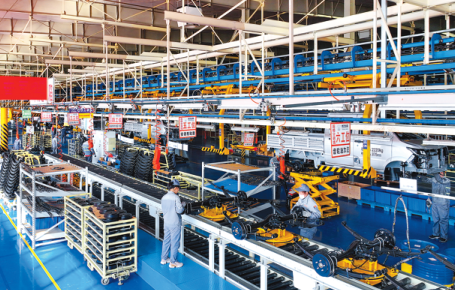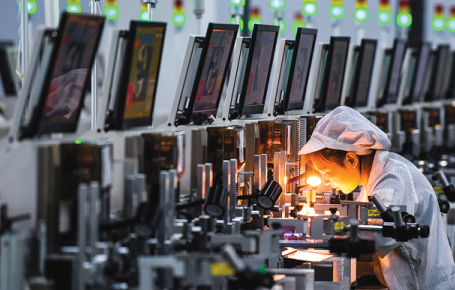Economic recovery in Shanxi back on track
Updated: 2023-12-29

Workers of Shanxi-based Victory Auto assemble automotive parts on an automatic production line. [Photo by Zhang Guoping for China Daily]
Investments in modernization and clean energy among reasons why province has achieved growth
The North China province of Shanxi maintained steady growth in almost all socioeconomic fronts in the first 11 months of this year, showing it is on track to recovery and high-quality development.
Data released by the National Bureau of Statistics on Dec 11 showed that Shanxi's total grain output for this year reached 14.78 million metric tons and its per-hectare yield hit 4.68 tons. Both figures are provincial records.
Local officials said the steady growth in agriculture is the result of priorities placed on the sector by the province, with a string of moves to push forward upgrades toward modernization and continuous investment in rural infrastructure.
Statistics for the industrial sectors, which were released by the Shanxi Statistics Bureau on Dec 20, added encouragement.
During the 11 months, the combined incremental value of industrial enterprises above designated size – those with annual revenue of 20 million yuan ($2.8 million) or more – in Shanxi increased 4.5 percent year-on-year.
Officials said the province's economic transformation campaigns – which aim to reduce reliance on coal mining and other traditional heavy industries, cultivate strategic emerging industries as new growth engines and promote industrial digitalization – have contributed to the stable industrial growth.
Longcheng Malleable Iron, based in the central Shanxi city of Jinzhong, is an example of how industrial enterprises are using digital technologies to upgrade their operations.
On Dec 24, the company announced that all the conventional ball grinders at its product plants had been replaced by digital ball-grinding machines.
A company executive said such an upgrade can greatly save labor costs, improve work efficiency and make production more environmentally friendly. "This is only the beginning of our large-scale technological upgrade," the executive said. "We will have more new equipment, technologies and techniques applied in the near future."
He added that Longcheng's transformation is in line with a province-wide intelligent manufacturing campaign launched by the provincial government several years ago, which calls for the use of digital technologies to increase operational efficiency and improve product quality.
While manufacturing industries in Shanxi are becoming smarter, the energy industry there is going both smarter and greener.
The province is implementing an energy revolution program, which highlights developing new and renewable energy resources and upgrading the coal mining industries toward the directions of cleaner, more efficient and safer operations with the use of smart, digital technologies.
Shanxi now has nearly 30 percent of its electricity generated by facilities powered by new energy resources like wind and solar power.
Since the operation of China's first 5G intelligent coal mine – the Xinyuan Coal Mine in the city of Yangquan – in 2020, Shanxi has developed a total of 48 intelligent coal mines and built 1,200 smart coal-mining shafts to date. These achievements have made the province one of the national leaders in coal mining digitalization.
Digital technologies and smart equipment are also used in other heavy industries like steelmaking. Taiyuan Iron and Steel Group, the leading steelmaker in Shanxi, for instance, has completed the digital renovation of its key production facilities. The digitalized upgrade of its plant for the production of steel plates with a width of 4,300 millimeters was finished recently.
"The upgrade has yielded great efficiency," said an executive of the company. "Production of such a steel plate can be finished in only five minutes."
Backing the digitalized and intelligent development of industries is a growing number of high-tech enterprises, research entities and innovation platforms in Shanxi.

A staff member of Gaoke Huaxing Electronics, a high-tech company in Changzhi city, checks a product's quality at the company's manufacturing plant. [Photo by Li Ning for China Daily]
The province is now home to 32 national-level corporate technology centers and 469 such entities at provincial level.
Local officials said these centers have established close cooperative ties with research institutions and universities throughout the country, allowing the sharing of resources nationwide.
Some traditional manufacturing enterprises have transformed themselves into high-tech businesses, becoming a major force supporting Shanxi's industrial digitalization.
Taiyuan Heavy Machinery Group, for instance, has been a major supplier of mining machines in Shanxi. Its enhanced investment in research and development now makes it a leading supplier of intelligent machines and solutions for mining and related industries.
According to an executive of the company, its offerings include 5G-connected and remote-controlled intelligent coal-cutting machines, smart solutions for coking and smart cranes.
"We are stepping up the construction of a smart equipment manufacturing industrial park in Taiyuan," the executive said. "When it is operational, it will offer further technological support to the mining industry in China and in the world."
While devoting energy to advancing its manufacturing industries, Shanxi has also stressed developing a dual-circulation pattern to boost domestic consumption and international trade.
The province has grasped the opportunity of a tourism boom to promote the development of its consumer market.
During the first 10 months of this year, Shanxi's major tourist destinations received more than 75.9 million visits, increasing 156.23 percent from the same period of 2022.
To meet this surge in tourism, Shanxi has designed a number of characteristic streets in various cities. Featuring services like sightseeing, shopping and dining, these spots have proved a magnet for both tourists and local residents, garnering unexpected revenues, according to a tourism official in Shanxi.
During the first three quarters of this year, Shanxi's sales volume of consumer goods reached 583.62 billion yuan, increasing 3.7 percent from the same period of 2022, according to local statistics.
To promote high-quality opening-up and assist international trade and investment, Shanxi organized a series of trade and investment promotions this year in Europe, Southeast Asia and Oceania. In addition, the province has used domestic trade shows, like the China International Import Expo in Shanghai and the China Import and Export Fair in Guangzhou to promote its trade and investment ties with the world.
He Kai and Zhang Yi contributed to this story.



